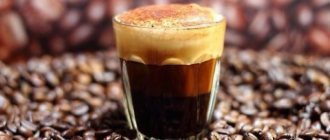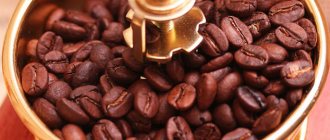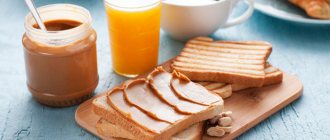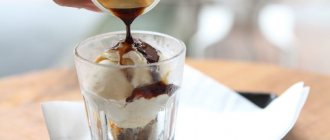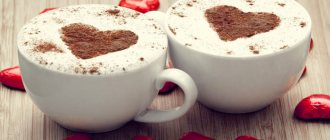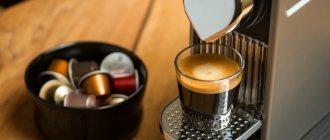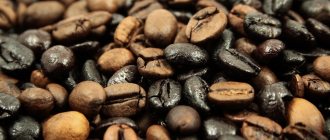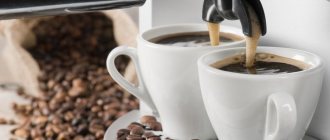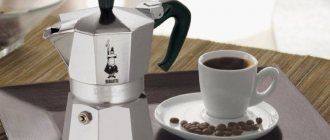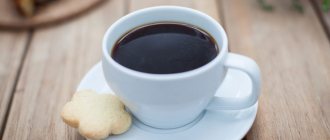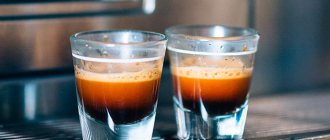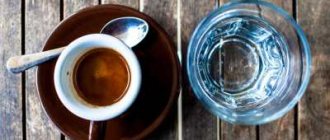What is espresso?
Espresso is the Italian answer to your immediate caffeine need. The word itself conveys the very essence contained in this drink. That's right, it cooks instantly in an espresso machine and this shot needs to be drunk instantly.
What else is special? For example, the fact that it is brewed at high temperatures (almost boiling!), and under high pressure water passes through finely ground coffee. Espresso is denser and more concentrated than filter coffee.
Shot of espresso in the process of preparation.
In addition to the fact that espresso is consumed in its pure form, it also serves as the basis for the preparation of many delicious drinks, such as Americano, cappuccino, flat white, latte... They differ in the amount of frothed milk or hot water added.
Latte and latte art.
Misspelling of the word "espresso"
The spelling of the word "expresso" is considered misspelled. The acceptable and correct option is “espresso” without the letter “k”. It is unknown how the rule regarding this lexeme will change in the future, but it is assumed that the spelling "expresso" will be acceptable. So far, these are just speculations and assumptions, which are categorically rejected by linguists and morphologists.
A literate person understands that the only correct decision is to choose the “espresso” option; the letter “k” is absent in this word form.
And the word “express” is used to mean “train” or something “urgent”. The spelling and pronunciation of this lexical unit must be memorized. If you have any difficulties, you need to consult a dictionary.
Espresso based drinks
Espresso
It is a coffee drink that is small in volume, strong and made from finely ground beans under high water pressure. Also, espresso should have crema. The ratio of the weight of ground coffee to the weight of the finished drink should be approximately 1:2... © "World Atlas of Coffee", James Hoffman
Americano
Interesting fact: filter coffee vs Americano! It all started with American soldiers and their love for black filter coffee.
The drink, which is prepared in an espresso machine, received the name “Americano” during the 2nd World War during the occupation of Italy by US troops. American soldiers, missing their homeland and missing black coffee, ordered unusually strong “Espresso” from Italian cafes and diluted it with hot water to make the drink look like filter coffee. Then the Italian baristas nicknamed him “Americano” (which means: American), and wrote down the recipe: “divine Espresso diluted with boiling water beyond recognition.”
Cappuccino
An espresso-based coffee drink with the addition of heated foamed milk. A thick layer of rich, creamy foam combined with sweet, warming milk and the rich flavor of a well-brewed espresso is an absolute delight... © The World Atlas of Coffee, James Hoffman
Flat white
Flat white - a coffee drink prepared by adding steamed milk with a small amount of foam to a double shot of espresso. Flat White was invented in the 1980s and there is still an ongoing debate about where Flat White was invented - in Australia or New Zealand, but undoubtedly somewhere there! A roaster and barista through experiments to find the balance between the flavors of coffee and milk. The barista eliminated the large amount of foam in the drink, reduced the proportions of milk (110 ml) and increased the amount of coffee (60 ml). ©Wikipedia
Latte
This drink was not invented in Italy. When espresso was tasted around the world, it was bitter, rich, and for many a completely new sensation. Some people didn't like the bitterness and added milk to make the drink smoother. Latte coffee was invented for such consumers. Typically, more milk is added to a latte to soften the taste than a cappuccino, but less cream. Many people know that if you order a latte in Italy, you can end up in an awkward position, because they will bring you a glass of... regular milk. ©The World Atlas of Coffee, James Hoffman
Raf
A purely Moscow invention. It was invented in 1996–1997 at Coffee Bean, the first coffee shop in Moscow opened according to the American model. When one of the regular guests, Rafael, asked to come up with something for him, three baristas - Gleb Neveikin, Artyom Berestov and Galina Samokhina - prepared coffee with cream and vanilla sugar. The drink began to be called “raf”. ©the Village
A complete list of espresso-based drinks can be found here: “39 Types of Coffee Drinks”
Is espresso bad for your health?
In short, no. Espresso, like regular black coffee, has many more advantages than disadvantages. First, it contains high levels of antioxidants but is low in calories. These advantages are the most obvious.
In addition, espresso improves long-term memory, the ability to concentrate, and improves mood. According to research, it can reduce the risk of stroke and type 2 diabetes. Some people even use espresso to perform better in their workouts. We can say with confidence that this drink does not negatively affect health.
However, one of espresso's obvious benefits is usually considered its worst drawback: caffeine. It is the latter that is responsible for the influx of energy that everyone so needs. However, there are limits to how much coffee you should drink.
How much caffeine is in an espresso shot?
One double shot of espresso will not ruin your health, but high coffee consumption may cause problems. It is known that caffeine can provoke insomnia and increase anxiety. In addition, high caffeine consumption can cause high blood pressure.
On the other hand, one shot of espresso only contains about 60 mg of caffeine. This amount is less than a quarter of the recommended daily intake. Now compare these numbers: 250 ml of coffee (usually people drink 350 ml) contains 95 mg. You'll end up consuming less caffeine than regular drip coffee.
So, if you drink 5-7 shots of espresso, your heart may go crazy. If you approach espresso consumption responsibly, then this drink will help you rather than harm you. However, as always, you need to pay attention to how your body reacts to substances like caffeine and act accordingly.
Anatomy of an espresso
Espresso is not just a drink that is denser and more concentrated than a filter. It consists of the following layers:
Crema
This is the golden brown top layer of espresso containing proteins, oils and melanoidins (derived from a combination of sugar and amino acids). Not all coffees produce dense crema, and this is often a topic of debate: some consider crema to be the source of bitterness in espresso, while others consider it a sign of a great shot.
Liquid
This is the main part of an espresso shot, combining both acidity and sweetness. It can also be considered by dividing it into two parts - the body and the heart. The body is the caramel-brown middle part of the drink. As for the heart, this is the base of the espresso, usually a richer, richer brown in color.
A cup of espresso.
Wait, isn't espresso coffee?
Yes. Coffee is a liquid that is obtained from beans, not a brewing process. A good cup of espresso can be obtained by specially preparing Robusta or Arabica coffee beans.
Think about how many different methods of making coffee there are: French press, pour over, percolator, etc. So, any espresso is coffee, but not all coffee is espresso.
Espresso is not a specific type of coffee bean. However, when roasting beans that are destined to become espresso, they may undergo special processing. Roasters typically use high quality Robusta beans to produce a richer coffee.
What is filter coffee and pour over?
Espresso and filter coffee are theoretically the same concept. In both cases, the base is hot water, interacting with ground grain, passes through a filter, is brewed, and as a result we obtain a finished drink.
But the key difference between filter and espresso is that with filter coffee, the water flows through the ground coffee beans without pressure, only gravity. For this reason, the brewing process takes a little longer, but the result will be just as excellent, albeit different.
And yet, thanks to all of the above, to prepare this coffee you will need much more ground beans and much more water. There is no 30ml Filter Coffee drink - or at least not for those coffee drinkers who would want to drink it.
A barista checks a pour-over brewing station.
Filter coffee, or as it is otherwise called - pour over and drip, as usual, is not so acidic and emphasizes the more subtle flavors of coffee. Therefore, pour overs are more popular among professionals for preparing single origin varieties.
Unlike espresso, with its density and layers, a good filter coffee is clean and balanced in taste. This is due to the fact that coffee oils and particles dissolve in more water in the time required for this process, without applying external pressure (force). Filter coffee has a milder taste because its acidity is much lower than that of espresso.
Filter coffee brewed in a Chemex.
So how long exactly does it take to prepare a filter?
When it comes to brewing time, filter coffee is a delicious cup of coffee that needs to wait a couple of minutes longer than espresso.
The process begins with pre-wetting the ground grain and waiting for “blooming,” which takes 30 to 40 seconds. This releases carbon dioxide and prepares the beans to allow water to flow smoothly and evenly through the ground coffee during brewing. The rest of the brewing process (post-bloom) is approximately 1½ to 4 minutes depending on the pour over.
Ready filter coffee.
As for espresso, by Italian standards it takes 25 to 30 seconds to prepare – no more, no less. If you are drinking a milk-based drink, add a few seconds to whisk and pour in the milk. Then in total (not counting the time for grinding the grain), the entire process takes about a minute (depending on your ability to do several things at once). This is the fastest way to get your coffee.
Freshly ground coffee in a portafilter, ready to become espresso.
So is there still an X in the word Espresso?
What do you do if a guest orders an espresso from you? Make faces and exchange banal jokes with your partner like: “I wonder if it’s an expresso to Sheremetyevo or to Domodedovo”? It just so happens that the word “expresso” in relation to a drink is considered bad form. Everyone remembers the campaign of the designer coffee resource Dear Coffee, I Love You under the slogan “There is no X in Espresso”? If you don’t remember, here is her most famous print:
In order to understand whether there is still an “X” in “espresso” (“K” in Russian translation) or not, you should turn to the history of the origin of the word. It’s worth starting with the fact that there is no single version of the translation. Espresso comes from the Italian esprimere, which means “to express, to show.” At the same time, another meaning of esprimere is “to squeeze out,” which rhymes well with the method of preparing a drink under steam pressure. The Italian word esprimere, in turn, comes from the Latin exprimere. This is where X comes from. The fact is that in Italian this letter is, in principle, not used and is replaced by S.
The word Express, meaning high-speed train or fast courier delivery, however, has the same roots. Exprimere - to express something specific; in relation to delivery - to send to a specific place. And since courier delivery over time began to be associated with fast delivery, the word Express became synonymous with speed. Hence the express train, which, to save time, goes non-stop from point to point.
But let's get back to espresso. “Expressed” in relation to a product means prepared at that moment, especially for the guest. So, “espresso” is 1) prepared at a specific moment for a specific person, 2) squeezed out with steam and 3) fast. Different dictionaries prioritize different versions. Perhaps one of them is right, or perhaps “espresso” is both.
Be that as it may, the ill-fated X always slipped in regarding the drink. For example, in The Gourmet's Guide to Europe of 1911, Nathaniel Newham-Davies points out that he was able to try Café Expresso in one of the Italian cafes (p. 261). In another, earlier book of 1869, Rome and Venice: with other wanderings in Italy, in 1866-7 (p. 294), George Augustus Sala, in his story about a visit to Italy, uses exactly this spelling of the word, through X. In many others testimonies, however, the name of the drink is written without an X. In the modern world, you can still easily find “expresso” on the menu of French, Spanish and even Icelandic cafes.
As for Spain, the commonly used name for the drink there is Cafe Solo, Cafe Expreso is more formal. Nevertheless, such an option exists, and despite the Italian origin of the word, the Spaniards adapted it to their language, that is, with an X and without the double S. English-language dictionaries recognize “expresso” as a non-standard, but still variant of the word “espresso”. What can we say, even spudge.com believes that saying “There is no X in Espresso” is the same as advocating the absence of U in the word color (and in English - color, in American English - color), that is It’s just that each country adapts the word to its own language, and there’s nothing wrong with that.
However, this is not the point. The story of the appearance or disappearance of the X in the word “espresso” is akin to the dispute over the gender of the word “coffee” in Russian. Once upon a time, coffee was called “coffee” and was clearly masculine. Then the word was modified, but the gender remained. This option, however, did not really take root in speech. Indeed, “coffee” sounds like a neuter word, so many people automatically applied the neuter gender to it. In the end, following the lead of the people, “coffee” was returned to the neuter gender as a possible option. The situation is similar with expresso. Yes, we all know that espresso is an Italian drink, and we, professionals, are obliged to pronounce its name in Italian, without any “X” or “K”. But, even if in dictionaries “expresso” is recognized as, albeit rarely used, but still a variant of the name of the drink, it may be worth softening your reaction. Lately, the stupid snickering about “expresso” has been much more annoying than the word itself. There is already too much unjustified snobbery and arrogance in the world of coffee, so should baristas pretend to be a Grammar Nazi and roll their eyes when yet another guest, far from coffee wisdom, orders an “expresso”?
Sources:
https://www.etymonline.com/index.php?term=espresso
https://english.stackexchange.com/questions/140022/what-is-the-origin-of-the-word-espresso
https://es.wikipedia.org/wiki/Café_expreso
https://sprudge.com/no-x-in-espresso-says-weird-al-yankovic-heres-hes-wrong.html
https://dictionary.reference.com/browse/expresso
What about brewing equipment?
When it comes to equipment, most basic filter coffee equipment (pour overs) are cheaper than buying a full-size espresso machine. This makes it less cost effective if you are not a professional or just starting to learn the coffee craft.
To filter coffee, all you need is a dripper, paper filters and a cup (although devices like a scale and thermometer will help you be more precise). There are different variations of drippers: Chemex, pour-over clover, Kalita, V60 and so on.
Each is made from different materials (plastic, glass, porcelain, etc.) and the difference between them is the size of the spill holes, the angle of inclination, the structure of the dripper, and so on.
Brewing Chemex
An espresso machine can cost you anywhere from a hundred dollars to several thousand dollars, depending on your needs. An espresso coffee maker for home use will cost much less, but due to insufficient water pressure, it is unlikely to be able to prepare the correct espresso, for example, the same as what a barista prepares in a coffee shop using a professional espresso machine.
And of course the dimensions! An espresso machine takes up a lot of space and requires a lot of electricity. You will also need additional gadgets to operate the espresso machine (tamper, portafilters, dispersion screens, baskets for them, etc.). This list can be replenished with new innovative cool devices, and they will also not be cheap.
Espresso machine La Marzocco.
How to drink espresso
First, let's order an espresso. If you ask for it at a coffee shop, most likely they will actually serve you a double shot - doppio. Some establishments will still ask you whether you want a double espresso or not. If you no longer plan to drink coffee on this day, then feel free to order a double shot.
Whatever you choose, espresso should be served in a ceramic cup called a demitas. In addition, water must be brought to him. If it is not there, then you should think about asking. Water is needed to get rid of other tastes and enjoy a wonderful espresso.
Now let's move on to the foam. There are several options here. Some people prefer to skim off the foam so as not to experience its sour taste. Others simply mix it with coffee before enjoying the drink.
You need to stir the coffee anyway. Thicker, richer oils tend to stay at the bottom, while the lighter, brighter flavors rise to the top. If you want the espresso to have a balanced flavor, stir it well.
It's time to drink! The main thing is not to drink espresso like a shot of alcohol. Instead, sip the drink slowly. Pay attention to the taste, aroma, aftertaste. Try to get as many impressions as possible. The most important thing is to enjoy.
Filter coffee or espresso: which is better?
There is no clear answer to this question.
Filter coffee is sometimes the best way to taste all the flavors of unique coffee varieties that cannot be prepared in espresso. The process of making pour-over coffee is slow and soothing, sometimes called slow coffee.
However, the brewing time for filter coffee is not comparable to making espresso. Espresso is prepared completely differently, using completely different techniques, and is an incredibly fast way to get a quick caffeine fix.
Something else to take into account is your own preferences. Due to its thick, creamy consistency, espresso works well with milk. The creaminess of frothed milk usually adds even more sweetness to espresso, and the combination can be enjoyed in drinks like lattes, cappuccinos and flat whites.
Filter coffee, in comparison, tastes cleaner, smoother and less acidic, which means it's more likely to be drunk without milk. This allows you to more clearly appreciate the balance of coffee taste, its flavor shades from floral, citrus to caramel and chocolate.
In the end, your best choice will be whatever suits your preferences. Remember that each method of preparing coffee can produce completely different results depending on the type and origin of the coffee, degree of roast, processing methods, etc.
And that's the most amazing thing about coffee, isn't it? This drink always has a lot of variety to offer. So what do you choose?
Why is there confusion with the words "express" and "espresso"?
Philologists explain the resulting confusion with the words “express” and “espresso” by the fact that people are influenced by an erroneous “etymology”, according to which the name coffee means a quickly prepared aromatic drink. According to experts at the Institute of Philology, this occurs as a result of the substitution of concepts, when a closer meaning of a word is assigned to another, similar in sound and spelling.
But the word forms “espresso” and “expresso” are not close in meaning or related. These are completely different units with their own lexical meaning and pronunciation. And calling coffee “expresso” in this case is indecent.
Classic cooking technology
The Italians claim that the quality of espresso depends on 4m:
- miscela (grain mixtures);
- macinadosatore (degree of grinding);
- maccina (coffee machines);
- mano (barista abilities).
Suitable coffee type
A mixture of 3-5 varieties of Arabica is used. Robusta is allowed to be mixed in small quantities to obtain a stronger drink with thick foam. There should be no aromatic additives.
It is not recommended to use ground coffee. It will lose its aroma after 2-3 weeks of storage. It is better to grind the grains immediately before cooking.
Choose a medium to dark roast. When choosing Italian or French, the sourness will disappear from the taste. At the same time, the bitterness will increase.
Grinding degree
The grind should be finer than medium, but coarser than fine. If you choose too large, the coffee will turn out to be liquid and will lose its taste. Excessively ground beans can clog the coffee maker filter.
Suitable coffee maker model
The right espresso coffee maker has a number of characteristics:
- The holder must be made of stainless steel. When heated, the plastic part will begin to spoil the aroma of the coffee. The drink will smell like chemical additives.
- The pressure in the chamber should be 9 bar. The pump should provide a reading of 15 bar.
- The temperature of the liquid in the boiler should increase to +87°...+95°. If the heat is too high, a burnt taste will appear, and if the heat is too low, the coffee will turn out liquid and not tart enough.
Preparatory stage
Do not pour too many beans into the holder, otherwise it will be difficult to tamp with the distemper. Make sure the coffee is pressed evenly. Water may pass through areas of lower density, causing the espresso to be thin.
Choose the right tamper. Avoid aluminum and plastic products. They are too fragile and will quickly become unusable.
Give preference to stainless steel tampers. For single holders, choose a product with a flat base. For doubles, rounded temperas are better suited.
Brewing Features
To compress beans for a carob coffee maker, you will need a force of 19-20 kg. Give preference to filtered water. Distilled liquid reduces the strength, too hard spoils the aroma.
Fill a slightly warmed ceramic cup with the finished drink. Do not pour from one container to another.
Is Turk suitable?
You won't be able to make espresso at home using a cezve. Ground grains in a Turk remain in a gradually heating liquid for a long time. Because of this, caffeine and essential substances are released differently. At home, it is possible to prepare Turkish black coffee in a cezve.
Homemade recipe
To prepare a classic espresso recipe at home, you will need 7 g of coffee beans and 40 ml of water. If desired, you can add granulated sugar. Connoisseurs claim that it spoils the taste and recommend refraining from using sweeteners.
If you are using a coffee machine with a built-in coffee grinder, add 1 tbsp. whole grains. For carob coffee makers, you will have to use pre-ground raw materials.
To measure quantities, use a measuring cup. Press the beans in the holder using a tamper, then place the part in the coffee maker. Place the cup in the drip tray and wait 25-30 seconds. Sweeten the finished drink if desired.
When you want to make another drink based on strong black coffee, use the same method as when making espresso.
